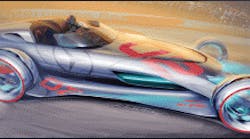Resources: |
The Advanced Design Center California, which serves as Mercedes-Benz’s North American R&D division, installed NVIDIA Maximus hardware on HP Z800 workstations to bolster the automotive OEM’s “extreme-car” design for the recent LA Auto Show Design Challenge. NVIDIA Maximus combines an NVIDIA Quadro professional graphics-processing unit (GPU) for high-end 3D graphics (in this case, the Quadro 6000) with the company’s new Tesla C2075 companion processor for heavy-duty number crunching. According to Mercedes, the technology transformed the studio’s workflow from a tedious, serial process to a parallel-processing setting that lets users perform 3D design, simulation, and visualization all at once and on the desktop.
“For Mercedes, this competition is a way to test new software and design technologies we might then apply to develop production cars,” says the studio’s chief designer, Christopher Rhoades. “Internally, it also demonstrates to Mercedes management in Germany the role and value of satellite design studios such as ours.”
In previous competitions, the design studio had used a quad-core CPU configured workstation. The design workflow began in 2D, went to 3D modeling, and finally on to visualization.
“Problem was, this approach forced designers to compromise, eliminating a lot of great features and dumbing things down because the studio’s computer wasn’t fast enough to perform high-end design and ray tracing (photorealistic rendering),” says Rhoades. “Ray tracing takes lots of calculations and can easily keep a computer busy for a day. The vehicle design entailed hundreds of frames per visualization, and each frame took 10 minutes to render, so we needed hundreds of hours of rendering time each week.” This almost completely monopolized the studio’s computers, so designers couldn’t do any other work while rendering took place.
“Even when we scheduled rendering for after work hours, there was always not enough time to complete everything,” says Rhoades. “This forced designers to make difficult choices about what would or wouldn’t be ray traced in the time available. As a result, we ran out of time to implement many nifty concepts for last year’s competition.”
This year was a different story, says Rhoades. “The Maximus-powered workstations let us quickly explore many different creative options.” The designers used Autodesk 3ds Max, Bunkspeed’s Move/Drive, Maya, Alias, Photoshop, and Adobe After Effects software.
“The Maximus setups give us a ‘render farm’ with just two machines,” says Rhoades. “Now when we create a photorealistic animation, we can design a scene and send it off to be rendered in the background in Bunkspeed,” he says. “Designers can then immediately start working on the next scene. Bunkspeed and Maximus work well together, giving us an almost instant feel for how a scene will look, a huge advantage in quickly creating the concept we want.”
The studio’s competition entry comprised a photorealistic animation titled Silver Lightning that included two “techno characters” in the form of the iconic Mercedes-Benz Silver Arrow race car and a crash-test dummy.
“The animation is like a movie trailer, with high-impact, exciting scenes,” says Rhoades. “We used the Maximus-equipped workstations to model and ray trace the car and dummy not only for the animation, but also for a movie poster and stills. We wanted the animation’s opening scene to be dramatic, so lighting was vital. Maximus let us highlight the scene with a ‘ray of sunlight’ as the focal point. We could not have done this before because we had no way to design and render at the same time.”
The studio expects that Mercedes-Benz production engineers will also start to use NVIDIA Maximus-equipped workstations because of the large data sets they handle. “With Maximus, computationally intensive processes will no longer bring workflows to a halt,” says Rhoades. “An engineer rendering on a Maximus workstation can continue doing 2D sketches, 3D modeling, and other tasks. The technology kept us all productive while designing and creating the animation. And it continues to bolster production on our normal jobs.”
